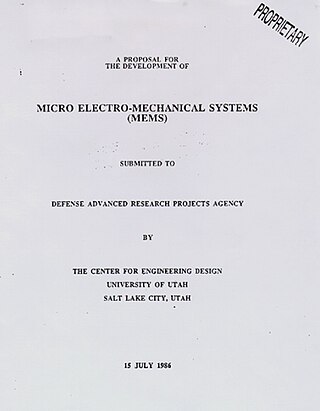
MEMS is the technology of microscopic devices incorporating both electronic and moving parts. MEMS are made up of components between 1 and 100 micrometres in size, and MEMS devices generally range in size from 20 micrometres to a millimetre, although components arranged in arrays can be more than 1000 mm2. They usually consist of a central unit that processes data and several components that interact with the surroundings.
Microtechnology deals with technology whose features have dimensions of the order of one micrometre. It focuses on physical and chemical processes as well as the production or manipulation of structures with one-micrometre magnitude.

An accelerometer is a tool that measures proper acceleration. Proper acceleration is the acceleration of a body in its own instantaneous rest frame; this is different from coordinate acceleration, which is acceleration in a fixed coordinate system. For example, an accelerometer at rest on the surface of the Earth will measure an acceleration due to Earth's gravity, straight upwards of g ≈ 9.81 m/s2. By contrast, accelerometers in free fall will measure zero.

Analog Devices, Inc. (ADI), also known simply as Analog, is an American multinational semiconductor company specializing in data conversion, signal processing, and power management technology, headquartered in Wilmington, Massachusetts.
Teledyne DALSA is a Canadian company specializing in the design and manufacture of specialized electronic imaging components as well as specialized semiconductor fabrication. Teledyne DALSA is part of the Teledyne Imaging group, the leading-edge imaging companies aligned under the Teledyne umbrella.
TDK Corporation is a Japanese multinational electronics corporation that manufactures electronic components and recording and data-storage media. Its motto is "Contribute to culture and industry through creativity".
ams OSRAM AG, formerly known as austriamicrosystems AG and ams AG, is an Austrian electronics company that designs and manufactures sensors for small form factor, low power, highest sensitivity and multi-sensor applications. Products include sensors, sensor ICs, interfaces and related software for mobile, consumer, communications, industrial, medical, and automotive markets.

Axis Communications AB is a Swedish manufacturer of network cameras, access control, and network audio devices for the physical security and video surveillance industries. Since 2015, it operates as an independent subsidiary of Canon Inc.

Nokia 5500 Sport is a smartphone running Symbian v9.1 operating system and the S60 3rd Edition user interface, announced on May 10, 2006. This was the first Nokia handset ever to feature text to speech and motion sensor features.
SPEA is an Italian company that designs and manufactures Automatic Test Equipment (ATE) for testing MEMS, Sensors, microchips and Printed circuit board.
OmniVision Technologies Inc. is an American subsidiary of Chinese semiconductor device and mixed-signal integrated circuit design house Will Semiconductor. The company designs and develops digital imaging products for use in mobile phones, laptops, netbooks and webcams, security and surveillance cameras, entertainment, automotive and medical imaging systems. Headquartered in Santa Clara, California, OmniVision Technologies has offices in the US, Western Europe and Asia.
Elmos Semiconductor SE is a German manufacturer of semiconductor products headquartered in Dortmund, North Rhine-Westphalia, Germany. Elmos supplies automotive application-specific integrated circuits (ASICs).
Safran Sensing Technologies Norway AS is a Norwegian producer and developer of high precision and light-weight MEMS gyros and IMUs, and also offers foundry services in its wafer fab. The company has 63 employees and is localised in Vestfold, Norway, with offices and fabs in Horten and at Skoppum. There is also a US subsidiary, Sensonor North America LLC, with offices in Orlando, FL. The CEO is Valérie Redron.
SensorDynamics was a European semiconductor and MEMS company specialized in developing and manufacturing high-volume micro- and wireless semiconductor sensor products for applications in automotive, industry and high-end consumer sectors. The company was acquired by Maxim Integrated in 2011 for $164 million. SensorDynamics developed and produced custom-made designs and standard components for use in vehicle stabilization, occupant protection, navigation systems, keyless go systems and autonomous energy generators for wireless and battery free controllers for industrial, automotive and high-end consumer application. With its headquarters in Graz, Austria, SensorDynamics had offices in Italy and Germany and a worldwide sales and distribution network. The company employed about 130 people in 2011.

An inertial navigation system is a navigation device that uses motion sensors (accelerometers), rotation sensors (gyroscopes) and a computer to continuously calculate by dead reckoning the position, the orientation, and the velocity of a moving object without the need for external references. Often the inertial sensors are supplemented by a barometric altimeter and sometimes by magnetic sensors (magnetometers) and/or speed measuring devices. INSs are used on mobile robots and on vehicles such as ships, aircraft, submarines, guided missiles, and spacecraft. Older INS systems generally used an inertial platform as their mounting point to the vehicle and the terms are sometimes considered synonymous.

CEA-Leti is a research institute for electronics and information technologies, based in Grenoble, France. It is one of the world's largest organizations for applied research in microelectronics and nanotechnology.

An inertial measurement unit (IMU) is an electronic device that measures and reports a body's specific force, angular rate, and sometimes the orientation of the body, using a combination of accelerometers, gyroscopes, and sometimes magnetometers. When the magnetometer is included, IMUs are referred to as IMMUs.
Microelectromechanical system oscillators are devices that generate highly stable reference frequencies to measure time. The core technologies used in MEMS oscillators have been in development since the mid-1960s, but have only been sufficiently advanced for commercial applications since 2006. MEMS oscillators incorporate MEMS resonators, which are microelectromechanical structures that define stable frequencies. MEMS clock generators are MEMS timing devices with multiple outputs for systems that need more than a single reference frequency. MEMS oscillators are a valid alternative to older, more established quartz crystal oscillators, offering better resilience against vibration and mechanical shock, and reliability with respect to temperature variation.
mCube is a fabless semiconductor company founded in 2009 and headquartered in San Jose, California, and has offices at multiple locations in Hsinchu, Taipei, Shanghai, and Shenzhen. mCube manufactures and provides the world’s smallest microelectromechanical systems (MEMS) motion sensors, The Key enablers for the New Internet of Moving Things (IoMT). Virtually anything that moves can take advantage of a motion sensor and thus it creates a huge market opportunity for MEMS manufacturers. By 2025, analysts predict more than 150 billion devices will be connected to the Internet and a large percentage of those devices will be in motion.
Adamant Co., Ltd. is a component manufacturing company based in Tokyo, Japan. Its name is from the word adamant, which was derived from the Greek word adamas meaning "diamond". At of its founding, Adamant's main products were watch jewels that were made of a hard material.








